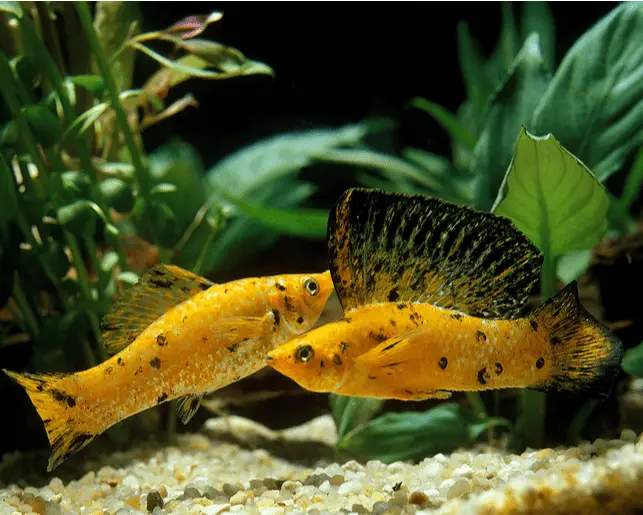Molly fish are a popular choice for aquarium enthusiasts due to their vibrant colors, active behavior, and ease of care. This makes them an ideal choice for hobbyists of all skill levels, from beginners to advanced.
Molly fish are social creatures and tend to form schools in their natural habitat. They are native to freshwater streams, estuaries, and coastal regions of North, Central, and South America. In the wild, they form large groups for protection against predators, to find food, and for reproduction purposes. Schools of molly fish are often observed swimming in unison, creating a mesmerizing display of movement and color.
In captivity, molly fish tend to exhibit similar behavior. They are known for their lively and active nature and can be seen swimming around their tank in groups. However, the behavior of molly fish can vary depending on their environment, tank mates, and the overall health of the fish.
The short answer is yes; different types of molly fish can school together. As social creatures, molly fish tend to form groups regardless of their color or variety. However, there are a few things to consider when mixing different types of molly fish.
For more information about the different kinds of mollies and their schooling behaviors, continue reading because we will discuss each of the listed molly’s behavior when it comes to schooling.

Black Molly Schooling Behavior
Black molly fish are sociable creatures and tend to do well in community aquariums. They are peaceful fish and generally get along well with other fish species. In fact, molly fish are known for their active and lively behavior, and they often swim around in groups, creating a mesmerizing display of movement and color.
In their natural habitat, molly fish are found in large schools for protection against predators, finding food, and for reproductive purposes. As such, they have evolved to be social creatures and tend to exhibit similar behavior in captivity.
It is important to note that while black molly fish are generally peaceful, they may exhibit territorial behavior towards their own species, especially during breeding periods. Therefore, it is recommended to keep a ratio of at least two female molly fish to every male to prevent excessive aggression.
Providing a suitable environment for black molly fish, including adequate space, hiding spots, and appropriate water conditions, can help keep them healthy and happy. Additionally, feeding a balanced diet and maintaining good water quality is crucial for their overall well-being.

Sailfin Molly Schooling Behavior
Sailfin mollies can school together with other types of molly fish, as they are all members of the same fish family, Poeciliidae. In the wild, different types of mollies can often be found swimming together in large schools for protection, finding food, and reproductive purposes.
In captivity, sailfin mollies are generally peaceful and sociable with other fish species, including other types of mollies. However, it is important to note that some species of mollies may exhibit territorial behavior towards their own species, especially during breeding periods. Therefore, it is recommended to keep a ratio of at least two female mollies to every male to prevent excessive aggression.
Additionally, it is important to ensure that the tank is not overcrowded and that all fish have adequate space and hiding spots to reduce stress and prevent aggression. Providing a balanced diet and maintaining good water quality is also crucial for the overall health and well-being of all fish in the aquarium.
Lyretail Molly Schooling Behavior
Lyretail mollies are peaceful fish and easy to take care for. However, they are known to form large schools, and it is recommended to have at least 5 of them to keep the group happy.
They rarely show evidence of hostile conduct, no matter the situation. The only thing you need to keep an eye out for is their behavior around fish with long fins, as they have a propensity to nip at the fins of other fish.
Balloon Molly Schooling Behavior
Balloon Mollies can get along well with other mollies, but their temperament and behavior can vary depending on several factors, including their individual personalities, gender, and the size of the aquarium.
In general, it’s best to keep a mix of males and females in a group, as keeping only males or only females can lead to aggression and stress. Balloon Mollies are generally peaceful fish and can coexist with other peaceful fish species, but they may become aggressive towards each other if they feel their territory or resources are being threatened. Therefore, it’s essential to provide enough space and hiding places in the aquarium, especially if there are multiple males in the group.
It’s also important to note that Balloon Mollies are more prone to health issues than other mollies, so they may require more care and attention to thrive in an aquarium environment. Keeping the water parameters stable, providing a healthy and varied diet, and monitoring the fish for any signs of illness are all essential to ensuring the health and happiness of your Balloon Mollies and other aquarium fish.
Dalmatian Molly Schooling Behavior
Dalmatian Mollies typically school well with other Molly fish as they are social fish that prefer to be in groups. In the wild, Mollies are known to form large schools for protection and mating purposes, and this social behavior usually carries over to the aquarium setting.
It’s also worth noting that Mollies are hardy fish that can tolerate a wide range of water conditions. However, they can be sensitive to high levels of nitrate and ammonia, so regular water changes and monitoring of water parameters are essential to keep them healthy and thriving.

What to do if your mollies aren’t getting on.
If your Molly fish aren’t getting along with each other, there are several things you can do to help promote peace and harmony in your aquarium.
Check the tank size and decor.
Molly fish are active swimmers that need plenty of space to swim and explore. If your tank is too small or overcrowded, your Molly fish may become stressed and territorial, leading to aggression towards each other. It’s recommended to have at least a 20-gallon tank for a small group of Molly fish. Additionally, providing plenty of hiding places, such as plants or decorations, can help reduce stress and create territories for each fish.
Check the male-to-female ratio.
Male Molly fish can become aggressive towards each other, especially if there are not enough females in the tank to disperse the male’s attention. A general rule of thumb is to have at least two female Molly fish for every male Molly fish. This helps to distribute the male’s attention and reduces aggression.
Check the water quality.
Poor water quality can cause stress and aggression in fish. It’s important to regularly test the water parameters and perform water changes as needed to maintain good water quality. High levels of ammonia and nitrite can be toxic to fish, leading to stress and aggression.
Check the feeding schedule and diet.
Molly fish are omnivores and need a balanced diet to maintain good health. Feeding your fish the right type and amount of food can help reduce aggression. Overfeeding can lead to obesity, which can cause health issues, including aggression. Try to feed your fish small amounts of food several times a day, and make sure the food you are feeding is nutritionally balanced.
Remove aggressive fish.
If one of your Molly fish is consistently aggressive towards others, it may be necessary to remove the aggressive fish from the tank. This will help reduce stress and aggression in the other fish and create a more peaceful environment.
Conclusion
In conclusion, different types of Molly fish can school together in an aquarium setting. However, it’s important to provide enough space, maintain a proper male-to-female ratio, and ensure that the water parameters are consistent with each fish’s requirements. With the right care and attention, a mixed community of Molly fish can thrive and create a beautiful and natural aquarium environment.

